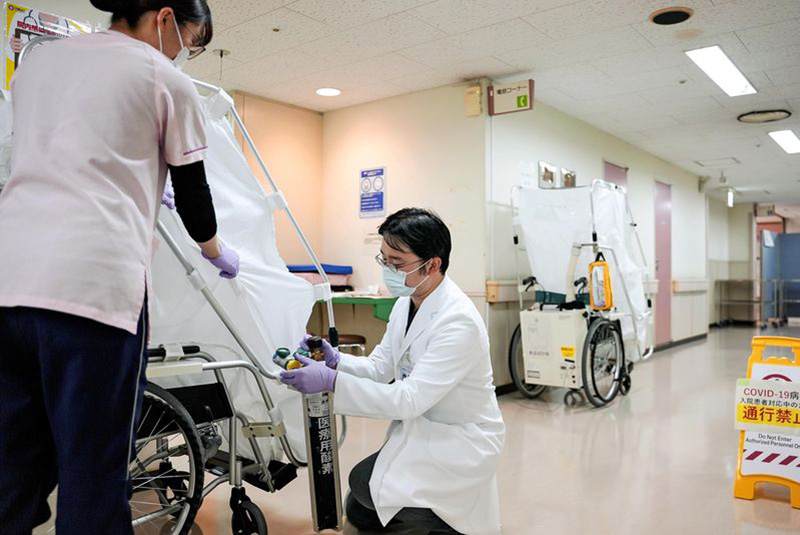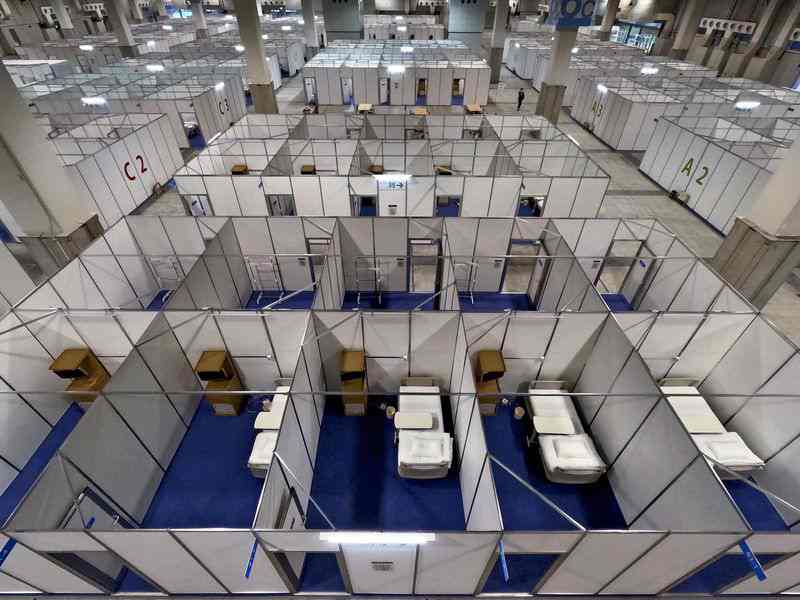
A doctors and nurse adjust a special wheelchair for omicron patients that is designed to prevent the coronavirus from spreading.
16:43 JST, January 9, 2022
Amid the rapid spread of the omicron variant of the novel coronavirus, prefectures are swiftly changing from a policy of hospitalizing all those infected, to having people stay at dedicated facilities or at their homes.
The move is aimed at avoiding a shortage of hospital beds, but there are concerns that the highly contagious variant could spread within households if infected people stay at home.
Private rooms

A temporary medical center built by the Osaka prefectural government in Osaka City in November last year
Tokyo Gov. Yuriko Koike announced on Friday a change from the policy of hospitalizing all patients, saying, “The Tokyo metropolitan government is implementing all possible measures for all patients, whether they are hospitalized, staying at designated facilities, or at home.”
The Health, Labor and Welfare Ministry initially called on prefectures to hospitalize, in principle, all patients infected with omicron. However, the increase in infections has made it difficult to maintain this policy. On Wednesday, the ministry issued a notice that it would allow patients to stay at home or at dedicated facilities.
As of Saturday, a total of 6,919 hospital beds had been secured for infected people in Tokyo, and there were 658 hospitalized patients. COVID beds were at 9.5% capacity, but the number of newly infected patients on that day exceeded 1,200.
Random testing showed that nearly 70% of the patients appeared to be infected with omicron. If they were all hospitalized, it would soon become difficult to keep up with the demand for beds.
Medical institutions have their own concerns as well, as the ministry has sought strict isolation of people infected with omicron. Multiple patients infected with the delta variant can stay in the same hospital room, but omicron patients need private rooms, in principle.
The Tokyo Medical and Dental University Hospital puts omicron patients in private rooms equipped with a negative pressure device to prevent air from leaking out, and also uses special wheelchairs equipped with such a device to move patients inside the hospital. However, there were only three private rooms at the hospital.
“It’ll be difficult [to put patients in private rooms] if infections surge,” said Dr. Sho Shibata.
Half change course
As of Thursday, the day after the notice was issued, 20 out of the 47 prefectures had changed their policies, according to the ministry. Tokyo and the prefectures of Chiba and Saitama later followed suit, so at least half of Japan’s prefectures have now changed their policy of hospitalizing all patients.
However, there are fears that people with omicron, which is said to be three to five times more infectious than delta, could spread it to family members living with them. The ministry has set conditions for home treatment, including the administration of oral drugs and the availability of home visits by doctors and nurses. However, how to respond to sudden changes in a patient’s condition is a concern.
The metropolitan government therefore intends to reduce the number of patients staying at home as much as possible for the time being. In line with the change in its policy, it will expand the number of designated facilities where infected people can be treated.
As of Sept. 1 last year, in the middle of the fifth wave, about 3,400 patients could be admitted to designated facilities. The metropolitan government aims to more than double this number to about 7,900.
“Patients at designated facilities can receive medical care immediately if their condition suddenly changes,” a metropolitan government official said.
The Osaka prefectural government is planning to use 10,000 existing rooms at designated facilities. When those facilities near their full capacity, it will put into operation a large temporary medical and recuperation center built in Osaka City in late October last year, which has 1,000 beds.
Speeding up care
The Kanagawa prefectural government intends to limit, to a certain extent, people at designated facilities to the elderly and those living with people who are at high risk of infection, and to allow many patients to recuperate at home.
There are currently about 2,100 rooms available in designated facilities in Kanagawa Prefecture. The prefectural government will promote cooperation with medical associations and home-visit nurse stations to ensure that patients can receive adequate care at home.
“We can’t increase the number of beds indefinitely,” a prefectural government official said.
"Society" POPULAR ARTICLE
-

M4.9 Earthquake Hits Tokyo, Neighboring Prefectures
-

Israeli Tourists Refused Accommodation at Hotel in Japan’s Nagano Pref., Prompting Protest by Israeli Embassy and Probe by Prefecture
-

M7.5 Earthquake Hits Northern Japan; Tsunami Waves Observed in Hokkaido, Aomori and Iwate Prefectures
-

Tsukiji Market Urges Tourists to Avoid Visiting in Year-End
-

High School in Kyoto Says Students Shoplifted during Recent School Trip to Bali, Indonesia
JN ACCESS RANKING
-

Tokyo Economic Security Forum to Hold Inaugural Meeting Amid Tense Global Environment
-

Keidanren Chairman Yoshinobu Tsutsui Visits Kashiwazaki-Kariwa Nuclear Power Plant; Inspects New Emergency Safety System
-

Imports of Rare Earths from China Facing Delays, May Be Caused by Deterioration of Japan-China Relations
-

University of Tokyo Professor Discusses Japanese Economic Security in Interview Ahead of Forum
-

Japan Pulls out of Vietnam Nuclear Project, Complicating Hanoi’s Power Plans



























